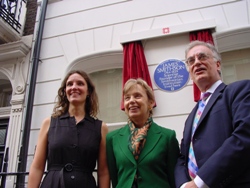
English Heritage erects blue plaque for founder of Smithsonian Institution. Eyewitness report for Geoscientist Online by Ted Nield
Geoscientist Online 26 September 2008
The founder of America's Smithsonian Institution, James Smithson (c. 1764 - 1829) was commemorated yesterday with an English Heritage blue plaque at 9 Bentinck Street, London, W1, where he resided briefly in 1825-1826. It was at this address in October 1826 that Smithson wrote the famous will that led to foundation of the Smithsonian Institution in Washington. Today, the Institution is the world's largest museum and research complex, and has helped shaped the national identity of the United States.
The plaque was unveiled by Smithson's biographer, Heather Ewing, following a speech by the Director of the Smithsonian Institution's Freer Gallery of Art and Arthur M. Sackler Gallery, Dr Julian Raby. The Society was represented by HOGG Chair, Dr Alan Bowden.
James Louis Smithson was born Jacques Louis Macie in Paris, the illegitimate son of Hugh Percy, second earl and later first Duke of Northumberland, and Elizabeth Macie (a wealthy widow and cousin of Percy's wife, the future Duchess of Northumberland). James changed his name from Macie to Smithson in 1800, when he was about thirty-five years old, following his mother's death, in order to align himself more publicly with his noble father-who had been known as Hugh Smithson before he married into the Percy family. In 1773 James was brought to London, and was naturalised. In 1782 he entered Pembroke College, Oxford, where he dedicated himself to chemistry, at a time when that field was undergoing tremendous development and discovery. As an undergraduate he travelled all over England and Scotland in search of minerals; in 1784 he made a tour of the west of Scotland, becoming one of the early scientists to visit Staffa to study its wondrous basaltic columns. James graduated in 1786 with a reputation as an outstanding mineralogist and chemist, and the following year was elected a fellow of the Royal Society.
In 1799 he was elected a proprietor of the Royal Institution, having been proposed by Sir Joseph Banks. A respected member of the scientific establishment, Smithson was admired especially for his pioneering micro-chemistry techniques, analyzing particles that were scarcely visible. In 1802 he overturned popular scientific opinion by proving that zinc carbonates were true carbonate minerals, not zinc oxides. One calamine (a type of zinc carbonate) was renamed 'smithsonite' in his honour in 1832.
Many of the papers James presented to the Royal Society and elsewhere were written on his extended travels in Europe; he believed that 'the man of science is of no country, the world is his country and all mankind his countrymen.' He spent more than two years as a prisoner of war during the Napoleonic Wars, and his release, signed off by Napoleon himself, was only made possible by the joint efforts of the Royal Society and the French Academy of Sciences. Although he returned periodically to England, the greater part of his adult life was spent abroad, living amidst the scientific circles of Paris, Florence, Berlin, and other cities. In Paris, where he lived the last fifteen years of his life, he split his time between the laboratory and the gaming tables, and his gambling was curtailed by the persuasion of his friend, the astronomer Dominique-Francois-Jean Arago. Years after Smithson's death, Arago would joke that, but for him, the Smithsonian Institution might never have been founded.
In 1826 Smithson enlisted the help of a pamphlet offering 'plain advice to the public, to facilitate the making of their own wills'. He had over £100,000 to bequeath, a fortune derived initially from his mother's family, which Smithson augmented substantially through investments; he had inherited nothing directly from his noble father. This Smithson left to his nephew and that young man's future children, adding that should he die without heir, the money was to pass 'to the United States of America to found at Washington under the name of the Smithsonian Institution an establishment for the increase and diffusion of knowledge among men.' Smithson died in 1829 and his nephew, still in his twenties, unmarried and without children, followed in 1835. After much debate in America about whether to accept such an unprecedented gift from a mysterious Englishman, and a two-year court case in the Court of Chancery, a hundred and five sacks of gold were shipped across the Atlantic. It was not until 1846 that the U.S. Congress finally reached agreement regarding the form the new educational institution should take, and work began on the Gothic Smithsonian Castle which was to house a museum, library, art gallery, chemical laboratory, and lecture rooms.